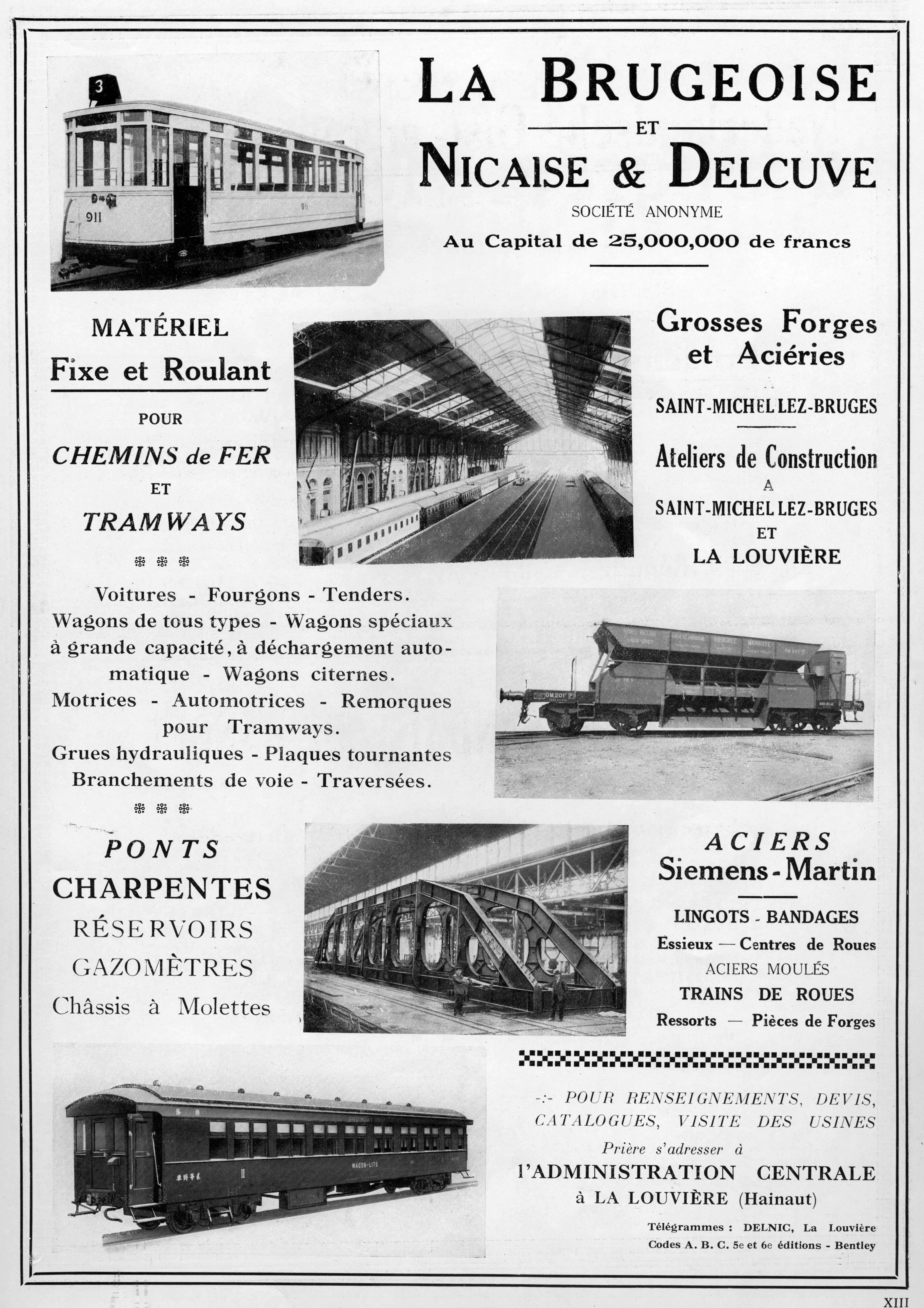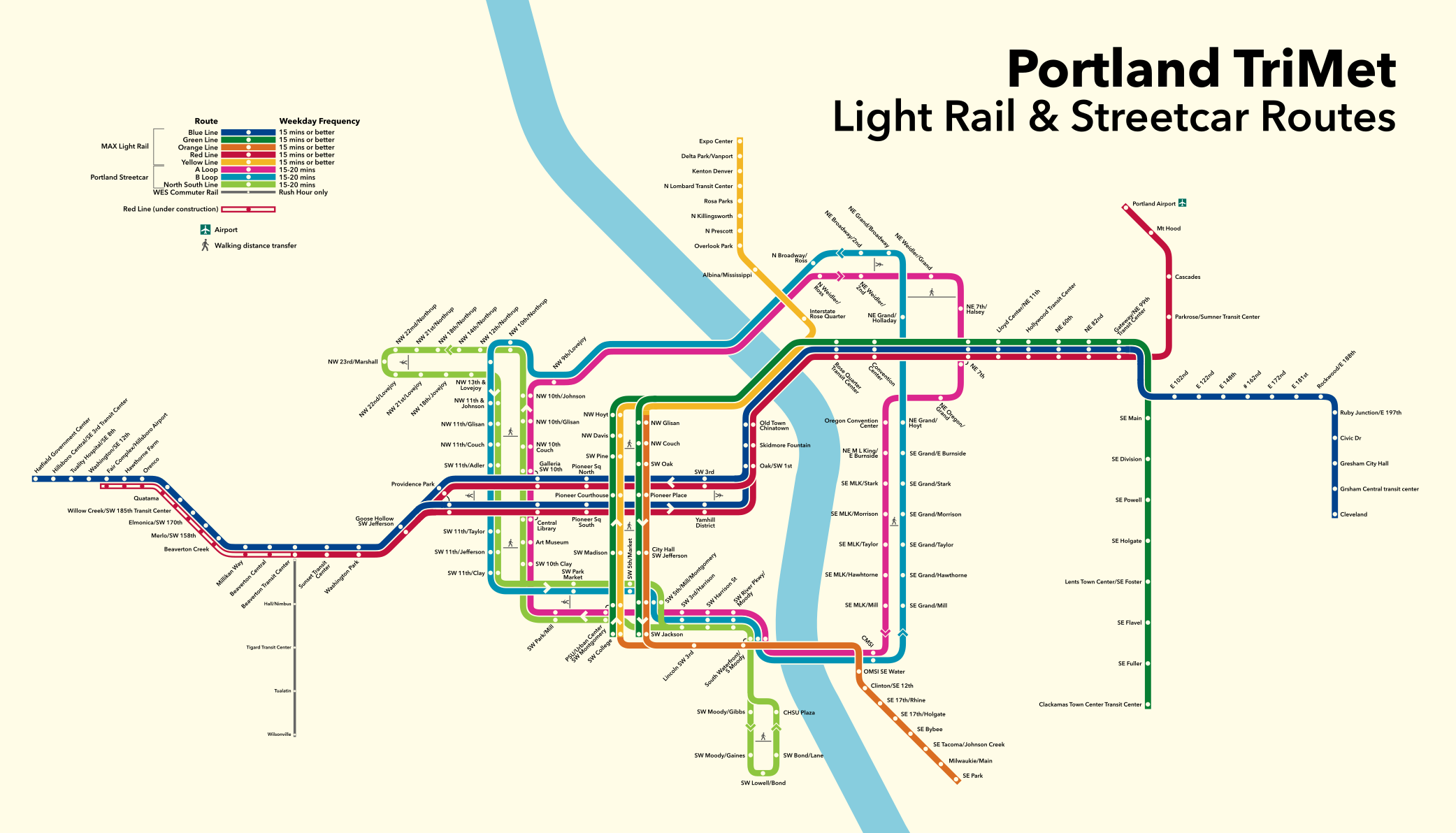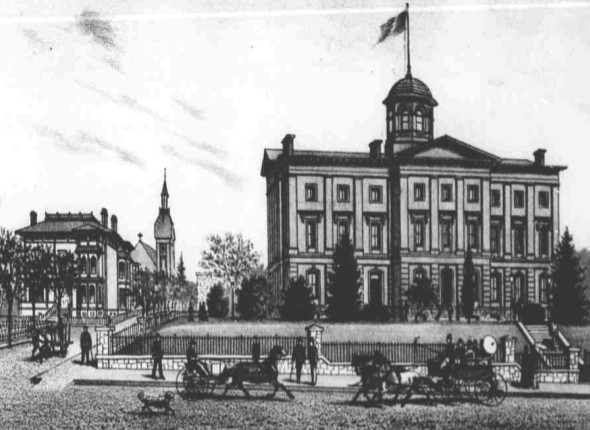|
La Brugeoise Et Nivelles
La Brugeoise et Nivelles, later BN Constructions Ferroviaires et Métalliques, was a Belgian manufacturer of railway locomotives and other rolling stock; it was formed by a merger of two companies: La Brugeoise et Nicaise et Delcuve and Les Ateliers Métallurgiques de Nivelles (French for "The Metallurgical Workshops of Nivelles"). The company was acquired by Bombardier Transportation in 1988, plants in Nivelles and Manage closed in 1989 and 2000; as of 2011, the plant located in Bruges operated as Bombardier Transportation Belgium. History In 1851, Joseph De Jaegher founded a hardware store in the Burg in Bruges; in 1855, this expanded with a steel workshop on the Raamstraat, named ''Ateliers J. Jaegher''; in 1891, this merged with another steel making company in the nearby Gieterijstraat, the Usines Ferdinand Feldhaus, to form the Ateliers de Construction Forges et Aceries de Bruges. By 1900, the company was a major Belgian metal engineering company. In 1905, the company m ... [...More Info...] [...Related Items...] OR: [Wikipedia] [Google] [Baidu] |
Bombardier Transportation
Bombardier Transportation was a Canadian rolling stock and rail transport manufacturer, with headquarters in Toronto and Berlin. It was one of the world's largest companies in the rail vehicle and equipment manufacturing and servicing industry. Bombardier Transportation had many regional offices, production and development facilities worldwide. It produced a wide range of products including Passenger car (rail), passenger rail vehicles, locomotives, bogies, Ground propulsion, propulsion and controls. In February 2020, the company had 36,000 employees, and 63 manufacturing and engineering locations around the world. Formerly a Division (business), division of Bombardier Inc., the company was acquired by French manufacturer Alstom on 29 January 2021. History 20th century 1970s: Formation and first orders Canadian company Bombardier Inc. entered the rail market in 1970 when it purchased Bombardier Transportation Austria GmbH, Lohner-Rotax of Austria. While Lohner built trams, ... [...More Info...] [...Related Items...] OR: [Wikipedia] [Google] [Baidu] |
Railway Gazette International
''Railway Gazette International'' is a British monthly business magazine and news website covering the railway, metro, light rail and tram industries worldwide. Available by annual subscription, the magazine is read in over 140 countries by transport professionals and decision makers, railway managers, engineers, consultants and suppliers to the rail industry. A mix of technical, commercial and geographical feature articles, plus the regular monthly news pages, cover developments in all aspects of the rail industry, including infrastructure, operations, rolling stock and signalling. History ''Railway Gazette International'' traces its history to May 1835 as ''The Railway Magazine'', when it was founded by Effingham Wilson. The ''Railway Gazette'' title dates from July 1905, created to cover railway commercial and financial affairs. In April 1914, it merged with ''The Railway Times'', which incorporated '' Herapath's Railway Journal'', and in February 1935 it absorbed the ''Railw ... [...More Info...] [...Related Items...] OR: [Wikipedia] [Google] [Baidu] |
Modern Tramway And Light Rail Transit
''Tramways & Urban Transit'' ''(TAUT'' or ''T&UT)'', also known as ''Modern Tramway'', is a British monthly magazine about tramways and light rail transport, published continuously since 1938. Its content is orientated both to tramway enthusiasts and to persons working in the tram transport field or studying tramways. It has been issued monthly from the beginning.Claydon, Geoffrey (June 1997). "Sixty Years of the LRTA". ''Light Rail & Modern Tramway'', pp. 227–228. Although published in Britain, the magazine's coverage is international, and its regular "World News" column includes detailed news on electric trams (called streetcars or trolleys in American English) and light rail worldwide.Saitta, Joseph P. (Ed.) (1981). Review of ''Modern Tramway'' in ''Traction Yearbook '81'', p. 230. Merrick, NY (US): Traction Slides International. Quote: "Necessary reading for those wishing to keep abreast of light rail progress." From 1938 until 2007 the magazine was published by the Ligh ... [...More Info...] [...Related Items...] OR: [Wikipedia] [Google] [Baidu] |
Bogie
A bogie ( ) (or truck in North American English) comprises two or more Wheelset (rail transport), wheelsets (two Railroad wheel, wheels on an axle), in a frame, attached under a vehicle by a pivot. Bogies take various forms in various modes of transport. A bogie may remain normally attached (as on many railroad cars and semi-trailers) or be quickly detachable (as for a dolly (trailer), dolly in a road train or in railway bogie exchange). It may include Suspension (vehicle), suspension components within it (as most rail and trucking bogies do), or be solid and in turn be suspended (as are most bogies of continuous track, tracked vehicles). It may be mounted on a swivel, as traditionally on a railway carriage or locomotive, additionally jointed and sprung (as in the landing gear of an airliner), or held in place by other means (centreless bogies). Although ''bogie'' is the preferred spelling and first-listed variant in various dictionaries, bogey and bogy are also used. Rail ... [...More Info...] [...Related Items...] OR: [Wikipedia] [Google] [Baidu] |
MAX Light Rail
The Metropolitan Area Express (MAX) is a light rail system serving the Portland metropolitan area in the U.S. state of Oregon. Owned and operated by TriMet, it consists of five lines connecting the Neighborhoods of Portland, Oregon, six sections of Portland; the communities of Beaverton, Oregon, Beaverton, Clackamas, Oregon, Clackamas, Gresham, Oregon, Gresham, Hillsboro, Oregon, Hillsboro, Milwaukie, Oregon, Milwaukie, and Oak Grove, Oregon, Oak Grove; and Portland International Airport to Downtown Portland, Oregon, Portland City Center. Trains run seven days a week with headways between 30 minutes off-peak and three minutes during rush hours. In 2023, MAX recorded an annual ridership of . MAX was among the first Light rail in the United States#"Second-generation" modern systems, second-generation American light rail systems to be built, conceived from Highway revolts in the United States, freeway revolts that took place in the 1970s. Planning for the network's inaugural easts ... [...More Info...] [...Related Items...] OR: [Wikipedia] [Google] [Baidu] |
Portland, Oregon
Portland ( ) is the List of cities in Oregon, most populous city in the U.S. state of Oregon, located in the Pacific Northwest region. Situated close to northwest Oregon at the confluence of the Willamette River, Willamette and Columbia River, Columbia rivers, it is the county seat of Multnomah County, Oregon, Multnomah County, Oregon's most populous county. Portland's population was 652,503, making it the List of United States cities by population, 28th most populous city in the United States, the sixth most populous on the West Coast of the United States, West Coast, and the third most populous in the Pacific Northwest after Seattle and Vancouver. Approximately 2.5 million people live in the Portland metropolitan area, Oregon, Portland metropolitan area, making it the List of metropolitan statistical areas, 26th most populous in the United States. Almost half of Oregon's population resides within the Portland metro area. Named after Portland, Maine, which is itself named aft ... [...More Info...] [...Related Items...] OR: [Wikipedia] [Google] [Baidu] |
Campinas
Campinas (, ''Plains'' or ''Meadows'') is a Brazilian Municipalities of Brazil, municipality in São Paulo (state), São Paulo State, part of the country's Southeast Region, Brazil, Southeast Region. According to the 2020 estimate, the city's population is 1,139,047, making it the List of cities in Brazil by population, fourteenth most populous Brazilian city and the São Paulo (state), third most populous municipality in São Paulo state, the fifth most populous municipality in Southeast Brazil, and the largest city in Brazil outside the metro region of a state capital. The city's metropolitan area, Metropolitan Region of Campinas, contains twenty municipalities with a total population of 3,656,363 people. Etymology Campinas means ''grass fields'' in Portuguese and refers to its characteristic landscape, which originally comprised large stretches of dense subtropical forests (mato grosso or thick woods in Portuguese), mainly along the many rivers, interspersed with gently rolling h ... [...More Info...] [...Related Items...] OR: [Wikipedia] [Google] [Baidu] |
São Paulo
São Paulo (; ; Portuguese for 'Paul the Apostle, Saint Paul') is the capital of the São Paulo (state), state of São Paulo, as well as the List of cities in Brazil by population, most populous city in Brazil, the List of largest cities in the Americas, Americas, and both the Western Hemisphere, Western and Southern Hemispheres. Listed by the Globalization and World Cities Research Network (GaWC) as an global city, alpha global city, it exerts substantial international influence in commerce, finance, arts, and entertainment. It is the List of largest cities#List, largest urban area by population outside Asia and the most populous Geographical distribution of Portuguese speakers, Portuguese-speaking city in the world. The city's name honors Paul the Apostle and people from the city are known as ''paulistanos''. The city's Latin motto is ''Non ducor, duco'', which translates as "I am not led, I lead." Founded in 1554 by Jesuit priests, the city was the center of the ''bandeirant ... [...More Info...] [...Related Items...] OR: [Wikipedia] [Google] [Baidu] |
Companhia Brasileira De Material Ferroviário
The Companhia Brasileira de Material Ferroviário (COBRASMA) () was a private company (Grupo Vidigal) responsible for manufacturing part of Brazil's railway equipment. At its peak, it employed nearly 6,900 people and had annual sales exceeding 200 million dollars. After a severe crisis, it ceased its manufacturing activities in May 1998, with a debt of approximately R$ 600 million. History During World War II, Brazilian railroads faced shortages of parts and supplies for maintenance, which were typically imported from the countries involved in the conflict. These countries, however, were redirecting their industries to support the war effort. In 1941, the state of São Paulo had a railway network spanning 7,388 kilometers, with 2,162 locomotives, 3,934 freight wagons, and 2,319 passenger cars. As the war progressed, the risk of the rail network collapsing due to the lack of parts increased. In 1942, the US government sent a technical mission to Brazil, led by Morris Llewellyn C ... [...More Info...] [...Related Items...] OR: [Wikipedia] [Google] [Baidu] |
Rio De Janeiro Metro
The Rio de Janeiro Metro (, ), commonly referred to as just the ''Metrô'' () is a rapid transit network that serves the city of Rio de Janeiro, Rio de Janeiro, Rio de Janeiro, Brazil. The Metrô was inaugurated on 5 March 1979, and consisted of five stations operating on a single line. The system currently covers a total of , serving 41 stations, divided into three lines: Line 1 (); Line 2 (), which together travel over a shared stretch of line that covers 10 stations of an approximate distance of ; and Line 4 (). Metrô Rio has the second highest passenger volume of the metro systems in Brazil, after the São Paulo Metro. Line 1 (Rio de Janeiro), Line 1 (orange line) serves Centro, Rio de Janeiro, downtown Rio, tourist areas in the South Zone (Rio de Janeiro), South Zone, and several neighbourhoods in the Rio de Janeiro#North Zone, North Zone. It is a semicircular line, and is fully underground. It runs from Uruguai Station to Ipanema/General Osório Station. Line 2 (Rio de Ja ... [...More Info...] [...Related Items...] OR: [Wikipedia] [Google] [Baidu] |
Line 2 (Rio De Janeiro)
Line 2 (Green) of the Rio de Janeiro Metro The Rio de Janeiro Metro (, ), commonly referred to as just the ''Metrô'' () is a rapid transit network that serves the city of Rio de Janeiro, Rio de Janeiro, Rio de Janeiro, Brazil. The Metrô was inaugurated on 5 March 1979, and consisted o ... serves working-class residential neighborhoods, extending from the city centre towards the North side of the city. It is a diagonal line, and almost completely above ground (mostly elevated). This line started as a light rail line, but for increasing commuters, it gradually changed to metro standards. It is elevated except for Estácio and Cidade Nova stations, which are underground and at-grade, respectively. External linksMap of Line 2 References Rio de Janeiro Metro lines Rio de Janeiro - Line 2 {{SouthAm-metro-stub ... [...More Info...] [...Related Items...] OR: [Wikipedia] [Google] [Baidu] |
Light Rail
Light rail (or light rail transit, abbreviated to LRT) is a form of passenger urban rail transit that uses rolling stock derived from tram technology National Conference of the Transportation Research Board while also having some features from heavy rapid transit. The term was coined in 1972 in the United States as an English equivalent for the German word ''Stadtbahn'', meaning "city railway". From: 9th National Light Rail Transit Conference Different definitions exist in some countries, but in the United States, light rail operates primarily along exclusive Right_of_way#Rail_right_of_way, rights-of-way and uses either individual tramcars or multiple units coupled together, with a lower capacity and speed than a long heavy rail passenger train or rapid transit system. Narrowly defined, light rail transit uses rolling stock that is similar to that of a traditional tram, while operating at a higher capacity and speed, often on an exclusive right-of-way. In broader usage, light ... [...More Info...] [...Related Items...] OR: [Wikipedia] [Google] [Baidu] |








